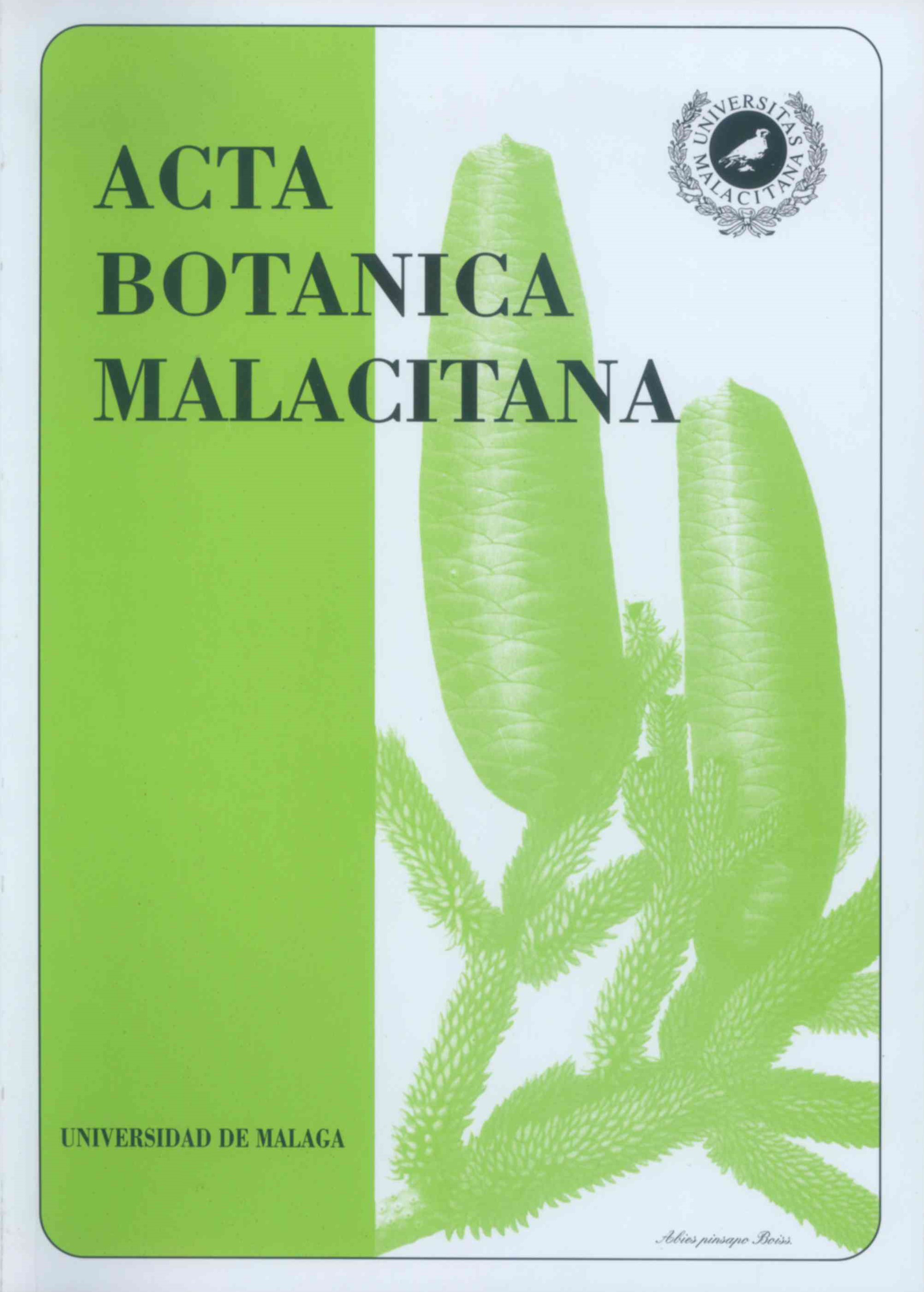Aquatic and helophytic vegetation of the northern Iberia'? System, central Spain
DOI:
https://doi.org/10.24310/abm.v26i0.7405Keywords:
Phytosociology, Spain, Iberian ranges, Potametea, Phragmito-MagnocariceteaAbstract
In this work, 11 associations and 4 communities belonging to the phytosociological classes Potametea and Phragmito- Magnocaricetea have been recognized. The Northern Iberian System is a southern border for Central- European plant-communities —Caricetum rostratae, Caricetum vesicariae and Community of Sparganium emersum—, as well as an eastern border for Atlantic plant-communities —Ranunculetum omiophylli, Galio broteriani-Caricetum broterianae. Glycerio declinatae-Eleocharitetum-palustris, Glycerio declinatae- Oenanthetum crocatae and Oenantho crocatae-Phalaridetum arundinaceae—.
Downloads
Metrics
References
ARNAIZ, C. y J. A. MOLINA -1986- Vegetación acuática y helofítica de la cuenca alta del río Guadarrama. Lazaron 8: 221-240.
BIURRUN, 1. -1999- Flora y vegetación de los ríos y humedales de Navarra. Guineana 5: + 1-338.
BRAUN-BLANQUET, J. -1979- Fitosociología. Bases para el estudio de las comunidades vegetales. Ed. H. Blume. Madrid. 820 pp.
CARRILLO, E. y J. M. NINOT -1992- Flora i vegetació de les valls d'Espot i de Boí (Flora and vegetation of the Espot and Boí valleys). Arxivs Secc. Ci. Inst. Estud. Catalans 99(1-2): 1-474 + 1-350.
CASTROVIEJO, S. et al., (eds.) -1986/2000- Flora lberica 1-8. CS1C.
CIRUJANO, S. -1995- Flora y vegetación de las lagunas y humedales de la provincia de Cuenca. Junta de Comunidades de Castilla-La Mancha, CSIC, Real Jardín Botánico. 224 pp.
DÍAZ, T.E. -1975- La vegetación del litoral occidental asturiano. Revista Fac. Ci. Univ. Oviedo 15(2)-16: 369-545.
FERNANDEZ GONZALEZ, F. -1988- Estudio floristico y fitosociológico del valle del Paular (Madrid). Mem. Doctoral id. Fac. Biol. Univ.
Complutense Madrid.
FERNÁNDEZ PRIETO, J.A., M.C. FERNANDEZ ORDÓÑEZ y M.A. COLLADO PRIETO -1987- Datos sobre la vegetación de las "turberas de esfagnos" galaico-asturianas y orocantábricas. Lazaroa 7:443-471.
GARCÍA-MIJANGOS, I. -1997- Flora y Vegetación de los Montes Obarenes (Burgos). Guineana 3. 458 pp.
GEHU, J. M. y S. RIVAS-MARTÍNEZ -1982- Notions fondamentales de phytosociologie. In H. Dierschke (ed.). Syntaxonomie, Ber. Int. Symp. Int. Vereinigung Vegetationsk. pp. 5-33. J. Cramer, Vaduz.
HARTOG, C. DEN y S. SEGAL -1964- A new classification of the water-plant communities. Acta Bot. Neerl. 13: 367-393.
HAURY, J. -1992- Les types éco-morphologiques des macrophytes intérét pour la description et la compréhension de la végétation des cours d'eau. ANPP. Quinzihne Conference Columa Journees Internationales d'Etudes sur la Lutte contre les Mauvaises Herbes 3: 1039-1047.
IGME -1970- Mapa geológico de Esparta, escala 1: 200.000, núm. 20. Burgos. Servicio de Publicaciones. Ministerio Industria y Energía. Madrid.
IGME -1980- Mapa geológico de España, escala 1: 200.000, núm. 21. Logroño. Servicio de Publicaciones. Ministerio Industria y Energía. Madrid.
IGME -1982- Mapa geológico de España, escala 1: 200.000, núm. 31. Soria. Servicio de Publicaciones. Ministerio Industria y Energía. Madrid.
ILLIES, J. y L. BOTOSANEANU -1963- Problémes et méthodes de la classification et de la zonation ecologique des caux courantes, considerées surtout du point de vue faunistique. Mitt. Int. Ver. Them-. Angew. Limnol. 12. 1-57.
LOIDI, J., I. BIURRUN y M. HERRERA -1997- La vegetación del centro-septentrional de España. ltinera Geobot. 9: 161-618.
LOPEZ PACHECO, M. J. -1988- Flora y vegetación de las cuencas altas y media del río Curtiefio (León). Diputac. Prov. León. Institución Fray Bernardino de Sahagún. 384 pp.
MOLINA, J.A. -1996- Sobre la vegetación de los humedales de la Península Ibérica (1. Phragmiti-Magnocaricetea). Lazaroa 16: 27-88.
MOLINA, J.A. y P.S. MORENO -1999- Syntaxonomy of the Oenanthe crocata communities in Western Europe. Plant Biosystems 133 (2): 107 115.
MOLINA, J.A. y S. SARDINERO -1998- Clasificación de las comunidades acuáticas del sector Celtibérico-Alcarreño (centro de la Peninsula Ibérica). Acta Bot. Malacitana 23: 89-98.
NAVARRO, G. -1986- Vegetación y flora de las Sierras de Urbión, Neila y Cabrejas. Mem. Doctoral id. Fac. Biol. Univ. Complutense Madrid.
NAVARRO, G. -1987- Datos sobre la vegetación acuática de las lagunas glaciares de Urbión y Ncila (Soria-Burgos). Lazaroa 7: 487-495.
NAVARRO, F. y C.J. VALLE -1984- Vegetación herbácea del centro-occidente zamorano. Stud. bot. 3: 63-177.
ORTIZ, S -1986- Series de vegetación y su zonación altitudinal en el macizo de Pella Trevinca y Serra do Eixo. Mem. Doctoral in. Fac. Biol. Univ. Santiago.
PARDO, L. -1948- Catálogo de los lagos de España. Inst. Forest. Invest. Experiencias 41: 1-522.
PÉREZ LATORRE, AV., A. GALÁN, P. NAVAS, D. NAVAS, Y. GIL y B. CABEZUDO -1999- Datos sobre la flora y vegetación del Parque Natural de los Alcornocales (Cádiz-Málaga, España). Acta Bot. Malacitana 24: 133-184.
PÉREZ MORALES, C. -1988- Flora y vegetación de la cuenca alta del río Bernesga (León). Diputac. Prov. León. Institución Fray Bernardino de Sahagún. 439 pp.
PIZARRO, J. -1995- Contribución al estudio taxonómico de Ranunculus L. subgen. Batrachium (DC.) A. Gray (Ranunculaceae). Lazaroa 15: 21-113.
RIVAS GODAY, S. -1964- Vegetación y flórula de la cuenca extremeña del Guadiana. Publ. Excma. Diputac. Badajoz. 779 pp.
RIVAS GODAY, S. y J. BORJA -1961- Estudio de la vegetación y flórula del Macizo de Gridar y Jabalambre. Anales Inst. Rot. Cavanilles 19: 1-538.
RIVAS-MARTÍNEZ, S. -1973 - Avance sobre una síntesis corológica de la Península Ibérica, Baleares y Canarias. Anal. Inst. Bot. Cavanilles 30: 69-87.
RIVAS-MARTÍNEZ, S. -1987- Mapa de las series de vegetación de España escala 1:400.000 y Memoria. Publ. 'CONA, Madrid.
RIVAS-MARTÍNEZ, S. y J. LOIDI -1999a- Bioclimatology of the Iberian Peninsula. In S. Rivas-Martínez, J. Loidi, M. Costa, T. E. Díaz y A. Penas. Iter Ibericum A.D. MIM. Itinera Geobot. 13: 5-347.
RIVAS-MARTÍNEZ, S. y J. LOIDI -1999b- Biogeography of the Iberian Peninsula. In S. Rivas-Martínez, J. Loidi, M. Costa, T. E. Díaz y A. Penas. Iter 1bericum A.D. MIM. Itinera Geobot. 13: 5-347.
SÁNCHEZ-MATA, D. -1989- Estudio de la flora y vegetación del macizo oriental de la sierra de Gredos (Ávila). Pub!. Diputac. Prov. Avila. 440 pp.
TUTIN, T.G. et al. (eds.) -1964-1980- Flora Europaea 1-5. Cambridge University Press. Cambridge.
Downloads
Published
How to Cite
Issue
Section
License
Copyright (c) 2019 Acta Botanica Malacitana

This work is licensed under a Creative Commons Attribution-NonCommercial-ShareAlike 4.0 International License.
All information related to the licensing of published works in Acta Botanica Malacitana and copyright can be found in our Editorial Policy.







1.png)
